List of mammals of peninsular Spain
This list shows the IUCN Red List status of 115 mammal species occurring in Spanish territory in the Iberian Peninsula. Seven species are endangered, thirteen are vulnerable, and three are near threatened. If the IUCN Red List status of a species in Spain differs from its global status, the status in Spain is shown next between brackets.[1]
The following tags are used to highlight each species' conservation status as assessed on the respective IUCN Red List:
| EX | Extinct | No reasonable doubt that the last individual has died. |
| EW | Extinct in the wild | Known only to survive in captivity or as a naturalized populations well outside its previous range. |
| CR | Critically endangered | The species is in imminent risk of extinction in the wild. |
| EN | Endangered | The species is facing an extremely high risk of extinction in the wild. |
| VU | Vulnerable | The species is facing a high risk of extinction in the wild. |
| NT | Near threatened | The species does not meet any of the criteria that would categorise it as risking extinction but it is likely to do so in the future. |
| LC | Least concern | There are no current identifiable risks to the species. |
| DD | Data deficient | There is inadequate information to make an assessment of the risks to this species. |
Order: Rodentia (rodents)[edit]


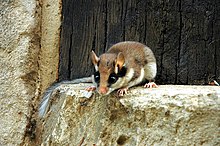


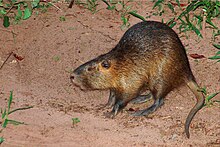
Rodents make up the largest order of mammals, with over 40% of mammalian species. They have two incisors in the upper and lower jaw which grow continually and must be kept short by gnawing. Most rodents are small though the capybara can weigh up to 45 kg (99 lb).
- Suborder: Castorimorpha
- Family: Castoridae (beavers)
- Subfamily: Castorinae
- Tribe: Castorini
- Genus: Castor
- Eurasian beaver, C. fiber LC[2][3]
- Genus: Castor
- Tribe: Castorini
- Subfamily: Castorinae
- Family: Castoridae (beavers)
- Suborder: Sciurognathi
- Family: Sciuridae (squirrels)
- Subfamily: Sciurinae
- Tribe: Sciurini
- Genus: Sciurus
- Red squirrel, S. vulgaris LC[4]
- Genus: Sciurus
- Tribe: Sciurini
- Subfamily: Xerinae
- Tribe: Marmotini
- Genus: Marmota
- Alpine marmot, M. marmota LC introduced
- Genus: Marmota
- Tribe: Marmotini
- Subfamily: Sciurinae
- Family: Gliridae (dormice)
- Subfamily: Leithiinae
- Genus: Eliomys
- Garden dormouse, E. quercinus NT[5]
- Genus: Eliomys
- Subfamily: Glirinae
- Genus: Glis
- European edible dormouse, G. glis LC
- Genus: Glis
- Subfamily: Leithiinae
- Family: Sciuridae (squirrels)
- Suborder: Myomorpha
- Family: Cricetidae (hamsters, voles, lemmings)
- Subfamily: Arvicolinae
- Genus: Arvicola
- Southwestern water vole, A. sapidus VU[6]
- European water vole, A. amphibius LC[7]
- Genus: Chionomys
- Snow vole, C. nivalis LC
- Genus: Microtus
- Cabrera's vole, M. cabrerae NT[8]
- Field vole, M. agrestis LC
- Common vole, M. arvalis LC
- Mediterranean pine vole, M. duodecimcostatus LC
- Gerbe's vole, M. gerbei LC
- Lusitanian pine vole, M. lusitanicus LC
- Genus: Clethrionomys
- Bank vole, C. glareolus LC
- Genus: Ondatra
- Muskrat, O. zibethicus LC introduced
- Genus: Arvicola
- Subfamily: Arvicolinae
- Family: Muridae (mice and rats)
- Subfamily: Murinae
- Genus: Apodemus
- Yellow-necked mouse, A. flavicollis LC
- Wood mouse, A. sylvaticus LC
- Genus: Micromys
- Eurasian harvest mouse, M. minutus LC
- Genus: Mus
- House mouse, M. musculus LC
- Algerian mouse, M. spretus LC
- Genus: Rattus
- Genus: Apodemus
- Subfamily: Murinae
- Family: Myocastoridae (coypu)
- Family: Cricetidae (hamsters, voles, lemmings)
Order: Lagomorpha (lagomorphs)[edit]

The lagomorphs comprise two families, Leporidae (hares and rabbits), and Ochotonidae (pikas). Though they can resemble rodents, and were classified as a superfamily in that order until the early 20th century, they have since been considered a separate order. They differ from rodents in a number of physical characteristics, such as having four incisors in the upper jaw rather than two.
- Family: Leporidae (rabbits, hares)
- Genus: Lepus
- Broom hare, L. castroviejoi VU[11]
- European hare, L. europaeus LC[12]
- Granada hare, L. granatensis LC[13]
- Genus: Oryctolagus
- European rabbit, O. cuniculus EN[14]
- Genus: Lepus
Order: Erinaceomorpha (hedgehogs and gymnures)[edit]

The order Erinaceomorpha contains a single family, Erinaceidae, which comprise the hedgehogs and gymnures. The hedgehogs are easily recognised by their spines while gymnures look more like large rats.
- Family: Erinaceidae (hedgehogs)
- Subfamily: Erinaceinae
- Genus: Atelerix
- North African hedgehog, A. algirus LC[15] introduced
- Genus: Erinaceus
- West European hedgehog, E. europaeus LC[16]
- Genus: Atelerix
- Subfamily: Erinaceinae
Order: Soricomorpha (shrews, moles, and solenodons)[edit]


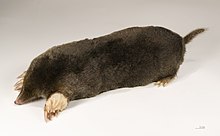
The "shrew-forms" are insectivorous mammals. The shrews and solenodons closely resemble mice while the moles are stout bodied burrowers.
- Family: Soricidae (shrews)
- Subfamily: Crocidurinae
- Genus: Crocidura
- Greater white-toothed shrew, C. russula LC
- Lesser white-toothed shrew, C. suaveolens LC[17]
- Genus: Suncus
- Etruscan shrew, S. etruscus LC
- Genus: Crocidura
- Subfamily: Soricinae
- Tribe: Nectogalini
- Genus: Neomys
- Southern water shrew, N. anomalus LC
- Eurasian water shrew, N. fodiens LC
- Genus: Neomys
- Tribe: Soricini
- Genus: Sorex
- Common shrew, S. araneus LC
- Crowned shrew, S. coronatus LC
- Iberian shrew, S. granarius LC
- Eurasian pygmy shrew, S. minutus LC
- Genus: Sorex
- Tribe: Nectogalini
- Subfamily: Crocidurinae
- Family: Talpidae (moles)
- Subfamily: Talpinae
- Tribe: Desmanini
- Genus: Galemys
- Pyrenean desman, G. pyrenaicus VU[18]
- Genus: Galemys
- Tribe: Talpini
- Genus: Talpa (genus)
- European mole, T. europaea LC
- Iberian mole, T. occidentalis LC
- Genus: Talpa (genus)
- Tribe: Desmanini
- Subfamily: Talpinae
Order: Chiroptera (bats)[edit]
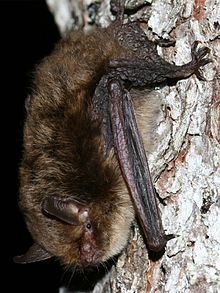

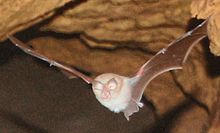
The bats' most distinguishing feature is that their forelimbs are developed as wings, making them the only mammals capable of flight. Bat species account for about 20% of all mammals.
- Suborder: Microchiroptera
- Family: Vespertilionidae
- Subfamily: Myotinae
- Genus: Myotis
- Alcathoe bat, M. alcathoe DD[19]
- Bechstein's bat, M. bechsteini NT[20]
- Lesser mouse-eared bat, M. blythii LC[21]
- Long-fingered bat, M. capaccinii VU[22]
- Cryptic myotis, M. crypticus
- Daubenton's bat, M. daubentonii LC[23]
- Geoffroy's bat, M. emarginatus LC[24]
- Escalera's bat, M. escalerai LC[25]
- Greater mouse-eared bat, M. myotis LC[26]
- Whiskered bat, M. mystacinus LC[27]
- Natterer's bat, M. nattereri LC[28]
- Genus: Myotis
- Subfamily: Vespertilioninae
- Genus: Barbastella
- Western barbastelle, B. barbastellus NT[29]
- Genus: Eptesicus
- Meridional serotine, E. isabellinus LC[30]
- Serotine bat, E. serotinus LC[31]
- Genus: Hypsugo
- Savi's pipistrelle, H. savii LC[32]
- Genus: Nyctalus
- Greater noctule bat, N. lasiopterus NT[33]
- Lesser noctule, N. leisleri LC[34]
- Common noctule, N. noctula LC[35]
- Genus: Pipistrellus
- Nathusius' pipistrelle, P. nathusii LC[36]
- Kuhl's pipistrelle, P. kuhlii LC[37]
- Common pipistrelle, P. pipistrellus LC[38]
- Soprano pipistrelle, P. pygmaeus LC[39]
- Genus: Plecotus
- Alpine long-eared bat, P. macrobullaris NT[40]
- Brown long-eared bat, P. auritus LC[41]
- Grey long-eared bat, P. austriacus NT[42]
- Genus: Barbastella
- Subfamily: Miniopterinae
- Genus: Miniopterus
- Common bent-wing bat, M. schreibersii VU[43]
- Genus: Miniopterus
- Subfamily: Myotinae
- Family: Molossidae
- Genus: Tadarida
- European free-tailed bat, T. teniotis LC[44]
- Genus: Tadarida
- Family: Rhinolophidae
- Subfamily: Rhinolophinae
- Genus: Rhinolophus
- Mediterranean horseshoe bat, R. euryale NT[45]
- Greater horseshoe bat, R. ferrumequinum LC[46]
- Lesser horseshoe bat, R. hipposideros LC[47]
- Mehely's horseshoe bat, R. mehelyi VU[48]
- Genus: Rhinolophus
- Subfamily: Rhinolophinae
- Family: Vespertilionidae
Order: Cetacea (whales)[edit]

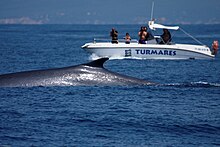

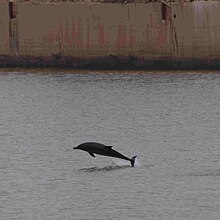
The order Cetacea includes whales, dolphins and porpoises. They are the mammals most fully adapted to aquatic life with a spindle-shaped nearly hairless body, protected by a thick layer of blubber, and forelimbs and tail modified to provide propulsion underwater.
- Suborder: Mysticeti
- Family: Balaenidae (right whales)
- Genus: Eubalaena
- North Atlantic right whale, E. glacialis CR[49]
- Genus: Eubalaena
- Family: Balaenopteridae (rorquals)
- Subfamily: Balaenopterinae
- Genus: Balaenoptera
- Blue whale, B. musculus EN[50]
- Sei whale, B. borealis EN
- Fin whale, B. physalus VU[51]
- Minke whale, B. acutorostrata LC[52]
- Genus: Balaenoptera
- Subfamily: Megapterinae
- Genus: Megaptera
- Humpback whale, M. novaeangliae LC[53]
- Genus: Megaptera
- Subfamily: Balaenopterinae
- Family: Balaenidae (right whales)
- Suborder: Odontoceti
- Family: Delphinidae (marine dolphins)
- Genus: Lagenorhynchus
- White-beaked dolphin, Lagenorhynchus albirostris LC
- Genus: Leucopleurus
- Atlantic white-sided dolphin, Leucopleurus acutus LC
- Genus: Steno
- Rough-toothed dolphin, S. bredanensis DD
- Genus: Stenella
- Striped dolphin, S. coeruleoalba LC[54]
- Atlantic spotted dolphin, S. frontalis LC[55]
- Genus: Delphinus
- Common dolphin, D. delphis LC[56]
- Genus: Globicephala
- Pilot whale, G. melas DD
- Short-finned pilot whale, G. macrorhynchus LC
- Genus: Grampus
- Risso's dolphin, G. griseus DD
- Genus: Feresa
- Pygmy killer whale, F. attenuata LC[57]
- Genus: Pseudorca
- False killer whale, P. crassidens NT[58]
- Genus: Orcinus
- Genus: Tursiops
- Common bottlenose dolphin, T. truncatus VU[60]
- Genus: Lagenorhynchus
- Family: Kogiidae (small sperm whales)
- Genus: Kogia
- Pygmy sperm whale, K. breviceps DD
- Dwarf sperm whale, K. sima DD
- Genus: Kogia
- Family: Phocoenidae (porpoises)
- Genus: Phocoena
- Harbour porpoise, P. phocoena VU
- Genus: Phocoena
- Family: Physeteridae (sperm whales)
- Genus: Physeter
- Sperm whale, P. macrocephalus VU
- Genus: Physeter
- Family: Ziphiidae (beaked whales)
- Genus: Ziphius
- Cuvier's beaked whale, Z. cavirostris DD
- Subfamily: Hyperoodontinae
- Genus: Hyperoodon
- Northern bottlenose whale, H. ampullatus DD
- Genus: Mesoplodon
- Sowerby's beaked whale, M. bidens DD
- Blainville's beaked whale, M. densirostris DD
- Gervais' beaked whale, M. europaeus DD
- True's beaked whale, M. mirus DD
- Genus: Hyperoodon
- Genus: Ziphius
- Family: Delphinidae (marine dolphins)
Order: Carnivora (carnivorans)[edit]




There are over 260 species of carnivorans, the majority of which feed primarily on meat. They have a characteristic skull shape and dentition.
- Suborder: Feliformia
- Family: Felidae
- Subfamily: Felinae
- Genus: Felis
- European wildcat, F. silvestris LC[61]
- Genus: Lynx
- Iberian lynx, L. pardinus EN[62]
- Genus: Felis
- Subfamily: Felinae
- Family: Viverridae
- Subfamily: Viverrinae
- Genus: Genetta
- Common genet, G. genetta LC introduced[63]
- Genus: Genetta
- Subfamily: Viverrinae
- Family: Herpestidae (mongooses)
- Genus: Herpestes
- Egyptian mongoose, H. ichneumon LC[64]
- Genus: Herpestes
- Family: Felidae
- Suborder: Caniformia
- Family: Canidae (dogs, foxes)
- Family: Ursidae (bears)
- Genus: Ursus
- Brown bear, U. arctos LC[67]
- Cantabrian brown bear, U. a. arctos
- Brown bear, U. arctos LC[67]
- Genus: Ursus
- Family: Procyonidae (raccoons)
- Family: Mustelidae (mustelids)
- Genus: Lutra
- European otter, L. lutra NT[68]
- Genus: Martes
- Beech marten, M. foina LC[69]
- European pine marten, M. martes LC[70]
- Genus: Meles
- European badger, M. meles LC[71]
- Genus: Mustela
- Stoat, M. erminea LC[72]
- European mink, M. lutreola CR[73]
- Least weasel, M. nivalis LC[74]
- European polecat, M. putorius LC[75]
- Genus: Neogale
- American mink, N. vison LC introduced[76]
- Genus: Lutra
Order: Artiodactyla (even-toed ungulates)[edit]



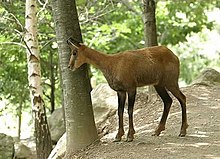
The even-toed ungulates are ungulates whose weight is borne about equally by the third and fourth toes, rather than mostly or entirely by the third as in perissodactyls. There are about 220 artiodactyl species, including many that are of great economic importance to humans.
- Family: Suidae (pigs)
- Family: Cervidae (deer)
- Subfamily: Cervinae
- Genus: Cervus
- Red deer, C. elaphus LC[78]
- Spanish red deer, C. e. hispanicus
- Red deer, C. elaphus LC[78]
- Genus: Dama
- European fallow deer, D. dama LC introduced[79]
- Genus: Cervus
- Subfamily: Capreolinae
- Subfamily: Cervinae
- Family: Bovidae
- Subfamily: Bovinae
- Subfamily: Caprinae
- Genus: Ammotragus
- Barbary sheep, A. lervia VU introduced[83]
- Genus: Capra
- Iberian ibex, C. pyrenaica LC[84]
- Southeastern Spanish ibex, C. p. hispanica
- Portuguese ibex, C. p. lusitanica EX
- Pyrenean ibex, C. p. pyrenaica EX
- Western Spanish ibex, C. p. victoriae
- Iberian ibex, C. pyrenaica LC[84]
- Genus: Ovis
- European mouflon, O. aries introduced
- Genus: Rupicapra
- Pyrenean chamois, R. pyrenaica LC[85]
- Genus: Ammotragus
Locally extinct[edit]

The following species are locally extinct in the area but continue to exist elsewhere:
- Alpine shrew, Sorex alpinus[86]
- Gray whale, Eschrichtius robustus[87][88]
- Eurasian lynx, Lynx lynx[89][90][91][92]
- Mediterranean monk seal, Monachus monachus[93]
- Wild horse, Equus ferus[94][95][96]
See also[edit]
References[edit]
- ^ Palomo, L. J.; Gisbert, J.; Blanco, J. (2007). "Libro Rojo de los Mamíferos Terrestres de España" (PDF). Atlas y Libro Rojo de los Mamíferos Terrestres de España. Madrid: Dirección General para la Biodiversidad-SECEM-SECEMU.
- ^ Batbold, J.; Batsaikhan, N.; Shar, S.; Hutterer, R.; Kryštufek, B.; Yigit, N.; Mitsain, G. & Palomo, L. (2016). "Castor fiber". IUCN Red List of Threatened Species. 2016: e.T4007A115067136.
- ^ Ceña, J.C. et al. (2004). Castor europeo en Navarra y La Rioja. Galemys: Boletín informativo de la Sociedad Española para la conservación y estudio de los mamíferos 16(2): 91–98.
- ^ Amori, G.; Hutterer, R.; Kryštufek, B.; Yigit, N.; Mitsain, G. & Muñoz, L. J. P. (2010). "Sciurus vulgaris". IUCN Red List of Threatened Species. 2010: e.T20025A9136220.
- ^ Bertolino, S.; Amori, G.; Henttonen, H.; Zagorodnyuk, I.; Zima, J.; Juškaitis, R.; Meinig, H. & Kryštufek, B. (2008). "Eliomys quercinus". IUCN Red List of Threatened Species. 2008: e.T7618A12835766.
- ^ Rigaux, P.; Vaslin, M.; Noblet, J. F.; Amori, G. & Muñoz, L. J. P. (2008). "Arvicola sapidus". IUCN Red List of Threatened Species. 2008: e.T2150A9290712.
- ^ Batsaikhan, N.; Henttonen, H.; Meinig, H.; Shenbrot, G., Bukhnikashvili, A., Hutterer, R., Kryštufek, B., Yigit, N., Mitsain, G. & Palomo, L. (2016). "Arvicola amphibius". IUCN Red List of Threatened Species. 2016: e.T2149A115060819.
{{cite journal}}: CS1 maint: multiple names: authors list (link) - ^ Fernandes, M.; Pita, R. & Mira, A. (2019). "Microtus cabrerae". IUCN Red List of Threatened Species. 2019: e.T13418A90931498.
- ^ Ruedas, L. (2016). "Rattus norvegicus". IUCN Red List of Threatened Species. 2016: e.T19353A165118026.
- ^ Kryštufek, B.; Palomo, L.J.; Hutterer, R.; Mitsain, G. & Yigit, N. (2015). "Rattus rattus". IUCN Red List of Threatened Species. 2015: e.T19360A115148682.
- ^ Ballesteros, F. & Smith, A. T. (2019). "Lepus castroviejoi". IUCN Red List of Threatened Species. 2019: e.T11797A503908.
- ^ Hacklande, K. & Schai-Braun, S. (2019). "Lepus europaeus". IUCN Red List of Threatened Species. 2019: e.T41280A45187424.
- ^ Soriguer, R. & Carro, F. (2019). "Lepus granatensis". IUCN Red List of Threatened Species. 2019: e.T41306A2953195.
- ^ Villafuerte, R. & Delibes-Mateos, M. (2019). "Oryctolagus cuniculus". IUCN Red List of Threatened Species. 2019: e.T41291A45189779.
- ^ Amori, G.; Hutterer, R.; Kryštufek, B.; Yigit, N.; Mitsain, G. & Palomo, L. J. (2008). "Atelerix algirus". IUCN Red List of Threatened Species. 2008: e.T27926A9481697.
- ^ Amori, G.; Hutterer, R.; Kryštufek, B.; Yigit, N.; Mitsain, G. & Palomo, L. J. (2008). "Erinaceus europaeus". IUCN Red List of Threatened Species. 2008: e.T29650A9508000.
- ^ Hutterer, R.; Amori, G.; Krystufek, B.; Yigit, N.; Mitsain, G. & Palomo, L.J. (2010). "Crocidura suaveolens". IUCN Red List of Threatened Species. 2010: e.T29656A9511068.
- ^ Fernandes, M.; Herrero, J.; Aulagnier, S. & Amori, G. (2008). "Galemys pyrenaicus". IUCN Red List of Threatened Species. 2008: e.T8826A12934876.
- ^ Hutson, A.M. & Paunović, M. (2016). "Myotis alcathoe". IUCN Red List of Threatened Species. 2016: e.T136680A518740.
- ^ Paunović, M. (2019). "Myotis bechsteinii". IUCN Red List of Threatened Species. 2019: e.T14123A22053752.
- ^ Juste, J. & Paunović, M. (2016). "Myotis blythii". IUCN Red List of Threatened Species. 2016: e.T14124A22053297.
{{cite journal}}: CS1 maint: multiple names: authors list (link) - ^ Hutson, A. M.; Spitzenberger, F.; Aulagnier, S.; Juste, J.; Karatas, A.; Palmeirim, J. & Paunovic, M. (2010). "Myotis capaccinii". IUCN Red List of Threatened Species. 2010: e.T14126A4399043.
{{cite journal}}: CS1 maint: multiple names: authors list (link) - ^ Kruskop, S.V.; Godlevska, L.; Bücs, S.; Çoraman, E. & Gazaryan, S. (2020). "daubentonii". IUCN Red List of Threatened Species. 2020: e.T85342710A22054773.
- ^ Piraccini, R. (2016). "Myotis emarginatus". IUCN Red List of Threatened Species. 2016: e.T14129A22051191.
- ^ Ibáñez, C. & Juste, J. (2017). "Myotis escalerai". IUCN Red List of Threatened Species. 2017: e.T85733126A85733299.
- ^ Coroiu, I.; Juste, J. & Paunović, M. (2016). "Myotis myotis". IUCN Red List of Threatened Species. 2016: e.T14133A22051759.
{{cite journal}}: CS1 maint: multiple names: authors list (link) - ^ Coroiu, I. (2016). "Myotis mystacinus". IUCN Red List of Threatened Species. 2016: e.T14134A22052250.
- ^ Gazaryan, S.; Kruskop, S.V. & Godlevska, L. (2020). "Myotis nattereri". IUCN Red List of Threatened Species. 2020: e.T85733032A22052584.
- ^ Piraccini, R. (2016). "Barbastella barbastellus". IUCN Red List of Threatened Species. 2016: e.T2553A22029285.
- ^ Juste, J. (2016). "Eptesicus isabellinus". IUCN Red List of Threatened Species. 2016: e.T85200107A85200275.
- ^ Godlevska, L.; Kruskop, S.V.; Gazaryan, S. (2020) [amended version of 2020 assessment]. "Eptesicus serotinus". IUCN Red List of Threatened Species. 2020: e.T85199559A195834153.
- ^ Hutson, A. M.; Spitzenberger, F.; Juste, J.; Aulagnier, S.; Palmeirim, J.; Paunovic, M.; Karatas, A. (2010). "Hypsugo savii". IUCN Red List of Threatened Species. 2010: e.T44856A10955205.
- ^ Hutson, A. M.; Alcaldé, J. T.; Juste, J.; Karataş, A.; Palmeirim, J. & Paunović, M. (2010). "Nyctalus lasiopterus". IUCN Red List of Threatened Species. 2010: e.T14918A4471682.
{{cite journal}}: CS1 maint: multiple names: authors list (link) - ^ Juste, J. & Paunović, M. (2016). "Nyctalus leisleri". IUCN Red List of Threatened Species. 2016: e.T14919A22016159.
{{cite journal}}: CS1 maint: multiple names: authors list (link) - ^ Csorba, G. & Hutson, A.M. (2016). "Nyctalus noctula". IUCN Red List of Threatened Species. 2016: e.T14920A22015682.
{{cite journal}}: CS1 maint: multiple names: authors list (link) - ^ Hutson, A. M.; Spitzenberger, F.; Juste, J.; Aulagnier, S.; Palmeirim, J.; Karatas, A. & Paunovic, M. (2010). "Pipistrellus nathusii". IUCN Red List of Threatened Species. 2010: e.T17316A6966886.
- ^ Juste, J. & Paunović, M. (2016). "Pipistrellus kuhlii". IUCN Red List of Threatened Species. 2016: e.T17314A22132946.
- ^ Godlevska, L.; Bücs, S.; Kruskop, S.V.; Gazaryan, S.; Benda, P. & Paunović, M. (2021) [errata version of 2020 assessment]. "Pipistrellus pipistrellus". IUCN Red List of Threatened Species. 2020: e.T85333513A196581936.
- ^ Benda, P.; Coroiu, I. & Paunović, M. (2016). "Pipistrellus pygmaeus". IUCN Red List of Threatened Species. 2016: e.T136649A21990234.
- ^ Hutson, A. M.; Aulagnier, S.; Juste, J.; Karatas, A.; Palmeirim, J. & Paunovic, M. (2010). "Plecotus macrobullaris". IUCN Red List of Threatened Species. 2010: e.T136229A4262709.
- ^ Gazaryan, S.; Kruskop, S.V. & Godlevska, L. (2021) [errata version of 2020 assessment]. "Plecotus auritus". IUCN Red List of Threatened Species. 2020: e.T85535522A195861341.
- ^ Gazaryan, S. & Godlevska, L. (2020) [amended version of 2020 assessment]. "Plecotus austriacus". IUCN Red List of Threatened Species. 2020: e.T85533333A195862345.
- ^ Gazaryan, S.; Bücs, S. & Çoraman, E. (2021) [errata version of 2020 assessment]. "Miniopterus schreibersii". IUCN Red List of Threatened Species. 2020: e.T81633057A19585652.
- ^ Benda, P. & Piraccini, R. (2016). "Tadarida teniotis". IUCN Red List of Threatened Species. 2016: e.T21311A22114995.
- ^ Juste, J. & Alcaldé, J. (2016). "Rhinolophus euryale". IUCN Red List of Threatened Species. 2016: e.T19516A21971185.
- ^ Piraccini, R. (2016). "Rhinolophus ferrumequinum". IUCN Red List of Threatened Species. 2016: e.T19517A21973253.
- ^ Taylor, P. (2016). "Rhinolophus hipposideros". IUCN Red List of Threatened Species. 2016: e.T19518A21972794.
- ^ Alcaldé, J.; Benda, P. & Juste, J. (2016). "Rhinolophus mehelyi". IUCN Red List of Threatened Species. 2016: e.T19519A21974380.
- ^ IUCN
- ^ Cooke, J.G. (2019) [errata version of 2018 assessment]. "Balaenoptera musculus". IUCN Red List of Threatened Species. 2018: e.T2477A156923585.
- ^ Cooke, J.G. (2018). "Balaenoptera physalus". IUCN Red List of Threatened Species. 2018: e.T2478A50349982.
- ^ Cooke, J. G. (2018). "Balaenoptera acutorostrata". IUCN Red List of Threatened Species. 2018: e.T2474A50348265.
- ^ Cooke, J.G. (2018). "Megaptera novaeangliae". IUCN Red List of Threatened Species. 2018: e.T13006A50362794.
- ^ Braulik, G. & Gaspari, S. (2019). "Stenella coeruleoalba". IUCN Red List of Threatened Species. 2019: e.T20731A50374282.
- ^ Braulik, G. & Jefferson, T. A. (2018). "Stenella frontalis". IUCN Red List of Threatened Species. 2018: e.T20732A50375312.
- ^ Braulik, G.; Jefferson, T. A. & Bearzi, G. (2021). "Delphinus delphis". IUCN Red List of Threatened Species. 2021: e.T134817215A50352620.
- ^ Braulik, G. (2018). "Feresa attenuata". IUCN Red List of Threatened Species. 2018: e.T8551A50354433.
- ^ Baird, R. W. (2018). "Pseudorca crassidens". IUCN Red List of Threatened Species. 2018: e.T18596A145357488.
- ^ Reeves, R.; Pitman, R. L.; Ford, J. K. B. (2017). "Orcinus orca". IUCN Red List of Threatened Species. 2017: e.T15421A50368125.
- ^ Bearzi, G.; Fortuna, C.; Reeves, R. (2012). "Tursiops truncatus". IUCN Red List of Threatened Species. 2012: e.T22563A2782611.
- ^ Gerngross, P.; Ambarli, H.; Angelici, F.M.; Anile, S.; Campbell, R.; Ferreras de Andres, P.; Gil-Sanchez, J.M.; Götz, M.; Jerosch, S.; Mengüllüoglu, D.; Monterosso, P. & Zlatanova, D. (2022). "Felis silvestris". IUCN Red List of Threatened Species. 2022: e.T181049859A181050999. doi:10.2305/IUCN.UK.2022-1.RLTS.T181049859A181050999.en. Retrieved 3 August 2022.
- ^ Rodríguez, A. & Calzada, J. (2015). "Lynx pardinus". IUCN Red List of Threatened Species. 2015: e.T12520A50655794.
- ^ Gaubert, P.; Carvalho, F.; Camps, D. & Do Linh San, E. (2015). "Genetta genetta". IUCN Red List of Threatened Species. 2015: e.T41698A45218636.
- ^ Do Linh San, E.; Maddock, A.H.; Gaubert, P. & Palomares, F. (2016). "Herpestes ichneumon". IUCN Red List of Threatened Species. 2016: e.T41613A45207211.
- ^ Boitani, L.; Phillips, M. & Jhala, Y. (2018). "Canis lupus". IUCN Red List of Threatened Species. 2018: e.T3746A119623865.
- ^ Hoffmann, M. & Sillero-Zubiri, C. (2016). "Vulpes vulpes". IUCN Red List of Threatened Species. 2016: e.T23062A46190249.
- ^ McLellan, B. N.; Proctor, M. F.; Huber, D. & Michel, S. (2017). "Ursus arctos". IUCN Red List of Threatened Species. 2017: e.T41688A121229971.
- ^ Roos, A.; Loy, A.; de Silva, P.; Hajkova, P. & Zemanová, B. (2015). "Lutra lutra". IUCN Red List of Threatened Species. 2015: e.T12419A21935287.
- ^ Abramov, A.V.; Kranz, A.; Herrero, J.; Krantz, A.; Choudhury, A. & Maran, T. (2016). "Martes foina". IUCN Red List of Threatened Species. 2016: e.T29672A45202514.
- ^ Herrero, J.; Kranz, A.; Skumatov, D.; Abramov, A.V.; Maran, T. & Monakhov, V.G. (2016). "Martes martes". IUCN Red List of Threatened Species. 2016: e.T12848A45199169.
- ^ Kranz, A.; Abramov, A. V.; Herrero, J. & Maran, T. (2016). "Meles meles". IUCN Red List of Threatened Species. 2016: e.T29673A45203002.
- ^ Reid, F.; Helgen, K. & Kranz, A. (2016). "Mustela erminea". IUCN Red List of Threatened Species. 2016: e.T29674A45203335.
- ^ Maran, T.; Aulagnier, S.; Libois, R.; Kranz, A.; Abramov, A. & Wozencraft, C. (2010). "Mustela lutreola". IUCN Red List of Threatened Species. 2010: e.T14018A4381596.
- ^ McDonald, R. A.; Abramov, A. V.; Stubbe, M.; Herrero, J.; Maran, T.; Tikhonov, A.; Cavallini, P.; Kranz, A.; Giannatos, G.; Kryštufek, B. & Reid, F. (2019). "Mustela nivalis". IUCN Red List of Threatened Species. 2019: e.T70207409A147993366.
- ^ Skumatov, D.; Abramov, A.V.; Herrero, J.; Kitchener, A.; Maran, T.; Kranz, A.; Sándor, A.; Stubbe, M.; Saveljev, A.; Savour-Soubelet, A.; Guinot-Ghestem, M.; Zuberogoitia, I.; Birks, J.D.S.; Weber, A.; Melisch, R. & Ruette, S. (2016). "Mustela putorius". IUCN Red List of Threatened Species. 2016: e.T41658A45214384.
{{cite journal}}: CS1 maint: multiple names: authors list (link) - ^ Reid, F.; Schiaffini, M.; Schipper, J. (2016). "Neovison vison". IUCN Red List of Threatened Species. 2016: e.T41661A45214988.
- ^ Keuling, O. & Leus, K. (2019). "Sus scrofa". IUCN Red List of Threatened Species. 2019: e.T41775A44141833.
- ^ Lovari, S.; Lorenzini, R.; Masseti, M.; Pereladova, O.; Carden, R.F.; Brook, S.M. & Mattioli, S. (2018). "Cervus elaphus". IUCN Red List of Threatened Species. 2018: e.T55997072A142404453.
- ^ Masseti, M. & Mertzanidou, D. (2008). "Dama dama". IUCN Red List of Threatened Species. 2008: e.T42188A10656554.
- ^ Lovari, S.; Herrero, J.; Masseti, M.; Ambarli, H.; Lorenzini, R. & Giannatos, G. (2016). "Capreolus capreolus". IUCN Red List of Threatened Species. 2016: e.T42395A22161386.
- ^ OKIA (9 October 2012). "Biggest bison transport ever Rewilding Europe".
- ^ "Segovia recibe nueve bisontes europeos para evitar su extinción". 20 Minutos. 20 April 2018. Retrieved 24 September 2019.
- ^ Cassinello, J.; Cuzin, F.; Jdeidi, T.; Masseti, M.; Nader, I. & de Smet, K. (2010). "Ammotragus lervia". IUCN Red List of Threatened Species. 2010: e.T1151A3288646.
- ^ Herrero, J.; Acevedo, P.; Arnal, M.C.; Fernández de Luco, D.; Fonseca, C.; García-González, R.; Pérez, J.M. & Sourp, E. (2020) [amended version of 2020 assessment]. "Capra pyrenaica". IUCN Red List of Threatened Species. 2020: e.T3798A195855497.
- ^ Herrero, J.; Lovari, S.; Nores, C. & Toigo, C. (2020). "Rupicapra pyrenaica". IUCN Red List of Threatened Species. 2020: e.T19771A171131310.
- ^ Palomo, L. J., Gisbert, J., & Blanco, J. C. (Eds.). (2007). Atlas y libro rojo de los mamíferos terrestres de España. Madrid: Organismo Autónomo de Parques Nacionales.
- ^ Rodrigues, Ana S. L.; Charpentier, Anne; Bernal-Casasola, Darío; Gardeisen, Armelle; Nores, Carlos; Pis Millán, José Antonio; McGrath, Krista; Speller, Camilla F. (2018). "Forgotten Mediterranean calving grounds of grey and North Atlantic right whales: Evidence from Roman archaeological records". Proceedings of the Royal Society B: Biological Sciences. 285 (1882). doi:10.1098/rspb.2018.0961. PMC 6053924. PMID 30051821.
- ^ Even though the Atlantic population is extinct, individuals from the Pacific still rarely disperse into the Atlantic. One was seen off the coast of Spain in 2010. IUCN.
- ^ Clavero, Miguel; Delibes, Miguel (2013). "Using historical accounts to set conservation baselines: The case of Lynx species in Spain". Biodiversity and Conservation. 22 (8): 1691–1702. doi:10.1007/s10531-013-0506-4. hdl:10261/80444. S2CID 17139682.
- ^ Rodríguez‐Varela, R.; García, N.; Nores, C.; Álvarez‐Lao, D.; Barnett, R.; Arsuaga, J. L.; Valdiosera, C. (2016). "AncientDNAreveals past existence of Eurasian lynx in Spain". Journal of Zoology. 298 (2): 94–102. doi:10.1111/jzo.12289.
- ^ Jiménez, J., Clavero, M., & Reig-Ferrer, A. (2018). New old news on the "Lobo cerval" (Lynx lynx?) in NE Spain.
- ^ Lucena-Perez, M., Bazzicalupo, E., Paijmans, J., Kleinman-Ruiz, D., Dalén, L., Hofreiter, M., ... & Godoy, J. A. (2022). Ancient genome provides insights into the history of Eurasian lynx in Iberia and Western Europe. Quaternary Science Reviews, 285, 107518.
- ^ Karamanlidis, A. & Dendrinos, P. (2015). "Monachus monachus". IUCN Red List of Threatened Species. 2015: e.T13653A45227543.
- ^ Nores, Carlos; Muñiz, Arturo Morales; Rodríguez, Laura Llorente; Bennett, E. Andrew; Geigl, Eva-María (2015). "The Iberian zebro: What kind of a beast was it?". Anthropozoologica. 50: 21–32. doi:10.5252/az2015n1a2. S2CID 55004515.
- ^ Pascual Barea, J. (2017). Equiferus hispanus o cebro ibérico: el caballo salvaje de la Península Ibérica desde la Antigüedad a época Moderna.
- ^ Pascual Barea, J. (2021). Equiferi y aquifolia: Cebros y acebos en la toponimia de la península ibérica.
Further reading[edit]
- Aulagnier, S. (2008). Guide des mammifères d'Europe, d'Afrique du Nord et de Moyen-Orient. Paris: Delachaux et Niestlé.
- Purroy, F. J.; Varela, J. M. (2003). Guía de los Mamíferos de España. Península, Baleares y Canarias. Barcelona: Lynx Edicions.
